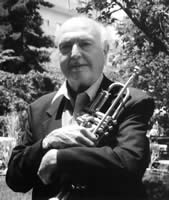John Coppola played with Louis Armstrong, Woody Herman, Dizzie Gillespie, Miles Davis, Charlie Mingus, Stan Kenton–a virtual who’s who of 20th century jazz. His resume includes first trumpet in national touring groups, recording sessions, live network television, theater, commercials and jingles. He has worked as a composer, arranger, musical director, bandleader, contractor, and teacher.
John Coppola was born in Geneva, NY in 1929. His family moved to Oakland, CA in 1937, where John apprenticed in his uncles shoe repair shop. He started ‘fooling around’ with the trumpet when he was nine. In junior high, John studied privately with a professional musician named Don Fraga. At age 13 he was hired for his first professional job, at the Oakland Motorcycle Club, by local 6 band leader Rudy Salvini.
During high school, John spent most of his time in the music room. No one seemed to mind, because the school was overcrowded with kids coming in from around the country to work in the shipyards. John remembers the gym coach telling his class on the first day of school, “Don’t worry about learning anything, except how to run fast, because you’re going to be dodging bullets.” During his senior year, the school band had six kids in the union, playing professionally. “That’s when I started working with the house band at Sweet’s Ballroom, in Oakland,” Says John, “I was making more money than the principal of the school–that got around fast.”
After high school, John went on the road briefly, with a band led by Tommy Reed. He then returned to the Bay Area, worked casuals, and joined a 22 piece Latin band led by Sal Guerrero. In 1950, John went to work for Charlie Barnet, one of the first artists to have a hit with ‘Cherokee’. They worked one-nighters, with short locations at various clubs and theaters, including Bop City in New York. In 1951, John was hired by Stan Kenton, and played in his Innovations Orchestra. A year later, John returned to the Bay Area where he received a notice to register for the draft. Luckily, his number did not come up. A short time later, John married Francis Lynne, a singer who had worked with Paul Desmond, Dave Brubeck, and Charlie Barnet.
After eight months on the road together, with the Billie May Band, the couple decided to settle in the Bay Area. They both worked casuals. John tried to get theater work, but it was hard to break into. He spent many nights playing strip clubs, where he began to worry about the musicality of the gigs. In 1954, John went back on the road with Kenton and did 73 straight one-nighters. “After that tour, you know, I felt like I needed a rest home.” Says John,” We were just on that bus, called it the Iron Lung. The best we did being in one place is we did two nights at Carnegie Hall.”
John returned home for a short while, and then received a call from Woody Herman. The Coppola’s moved to New York City, and although he did many one-nighters with Woody’s band, John liked it because they mostly worked the eastern seaboard and he played most of the leads. After three years with Woody, the Coppola’s returned to the Bay Area where John got lucky–he started working the theaters. “I did the civic light opera,” says John, “I did some good shows there, and I did some touring with the New York Company of Funny Girl.” John thought the music was great, and had no problem reading because the arranger was Ralph Burns, who was also the staff arranger for Woody Herman. “The conductor thought I was a great sight reader,” says John,” I’d been playing that stuff for three years, all the same figures, you know.” The show went down to L.A. where he was asked to continue with the tour, but decided to return home.
John began to do a lot of recording, especially demos for commercials. He was hired as Musical Director and Arranger for the Chevron School Broadcasts, which made educational programs (slide shows with dialogue and background music). He also became a staff musician for ABC on the Ernie Ford Show, the only network television show to come out of San Francisco. This in turn, led to more recording. During this time, John received some advice from local 6 band leader Ray Hackett. “He told me, ‘Buy a piece of property. Get some rental property, or you’re going to end up with nothing, kid.’” John bought three flats in San Francisco, which he still owns today.
In the mid-sixties, John led his own Octect twice a month in the east bay, where a talent scout from LA helped bring in guest soloists such as Ray Brown. In the late sixties, John did short tours with Henry Mancini, Petula Clarke, and even played Ronald Reagan’s inauguration in Sacramento. Through his connections in L.A., he became a first call player for stars traveling to the Bay Area. In the 1970’s, John became a constant presence at the Monterey Jazz Festival, where he played with greats such as Dizzie Gillespie and Miles Davis. Trade shows and conventions were also a solid source of income. In the 1980’s, John became a contractor for Wedgewood Productions, a company from Maryland that produced trade shows 15 or 20 times a year in San Francisco.
In 2001, John finally got to tour Europe. Today, he keeps a full schedule as musical director for the Green Street Mortuary Band, and as a clinician for the Monterey Jazz Festival. About his lifelong success, John is very humble. ”It was there to be done, you see, the opportunities where there.”

